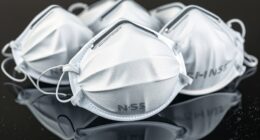If you’re looking for the best CO detectors for winter heater use, I recommend models with long-lasting batteries, reliable sensors, and easy installation. Devices like the First Alert CO605 and X-Sense XH02-M offer battery backup and smart features, ensuring safety during power outages. Quick-response sensors and multi-gas detection add extra protection. To choose the right one for your home, consider placement and maintenance. Keep going to discover more options that keep your family safe through winter.
Key Takeaways
- Choose detectors with long-lasting, sealed batteries or plug-in with battery backup for reliable operation during winter outages.
- Prioritize models with rapid response sensors and digital displays for real-time CO, temperature, and humidity monitoring.
- Ensure detectors have loud alarms (around 85dB) and visual alerts for effective early warning during sleep or from a distance.
- Install units in bedrooms, hallways, and near fuel-burning appliances, avoiding vents and high airflow areas for optimal safety.
- Opt for multi-gas detectors with certifications like UL and smart features for comprehensive safety during winter heating.
First Alert Carbon Monoxide Detector with Battery Backup (CO605)
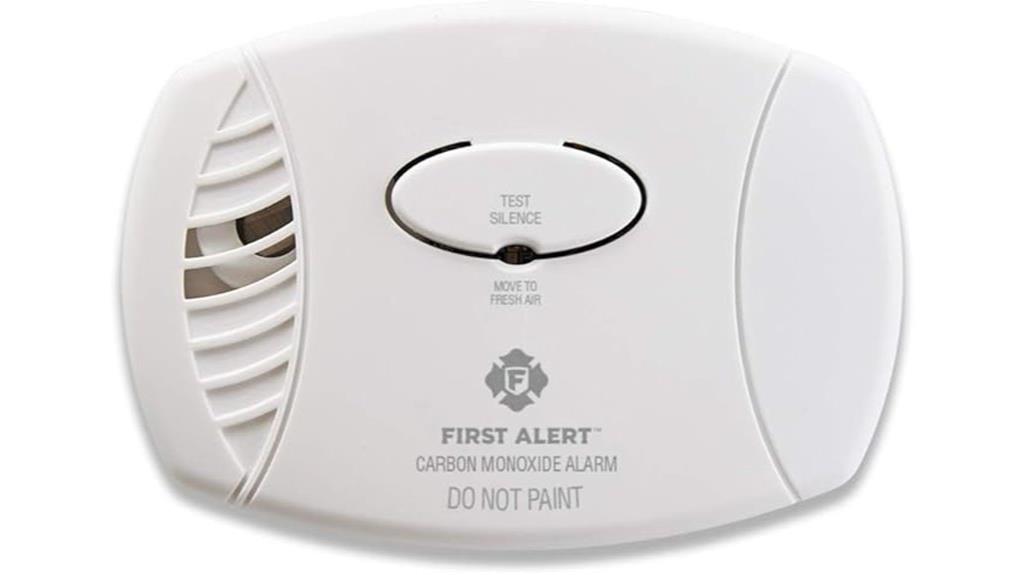
If you’re looking for a reliable CO detector that works seamlessly during winter power outages, the First Alert Carbon Monoxide Detector with Battery Backup (CO605) is an excellent choice. It’s a plug-in device with a battery backup, so it keeps working even if the power goes out. The advanced electrochemical sensor detects CO accurately, and the 85-decibel alarm quickly alerts you to dangerous levels. It’s simple to use, with a test/silence button, mute function, and end-of-life indicator. Compact and durable, it’s designed for long-term safety, meeting UL standards, and providing peace of mind during cold, dark months.
Best For: homeowners seeking a reliable, easy-to-install carbon monoxide detector that operates during power outages and provides long-term safety.
Pros:
- Equipped with a battery backup for continuous operation during power outages
- Features an advanced electrochemical sensor for accurate CO detection
- Simple to use with a test/silence button, mute function, and end-of-life indicator
Cons:
- Plug-in design may limit placement options away from outlets
- No digital display for real-time CO levels
- Requires replacement of the 9V battery after several years, despite a 7-year limited warranty
X-Sense Smart Heat Alarm XH02-M with Sealed Battery

The X-Sense Smart Heat Alarm XH02-M stands out for its 10-year sealed battery, making it an excellent choice for homeowners seeking reliable, maintenance-free fire detection. It requires an SBS50 base station (not included) and connects via 2.4 GHz Wi-Fi, supporting up to 50 devices for all-encompassing coverage. Equipped with an ultra-sensitive thermistor, it detects rapid or static temperature increases between 129°F and 149°F, reducing false alarms from smoke or fumes. The alarm sends real-time push notifications through the X-Sense app, allowing remote monitoring. Its easy test and silence button, combined with expandability, makes it a dependable addition to your home safety system.
Best For: homeowners seeking a maintenance-free, reliable heat detection solution with smart home integration and remote monitoring capabilities.
Pros:
- 10-year sealed battery eliminates the need for frequent replacements
- Supports up to 50 devices via the SBS50 base station for comprehensive home coverage
- Sends real-time push notifications for alarms, faults, and status updates through the app
Cons:
- Requires an additional SBS50 base station (not included) for operation
- Compatible only with 2.4 GHz Wi-Fi, not 5.0 GHz networks
- Does not connect directly to the X-Sense Home Security App, limiting standalone functionality
TOPTES CT-580 Portable Carbon Monoxide Detector
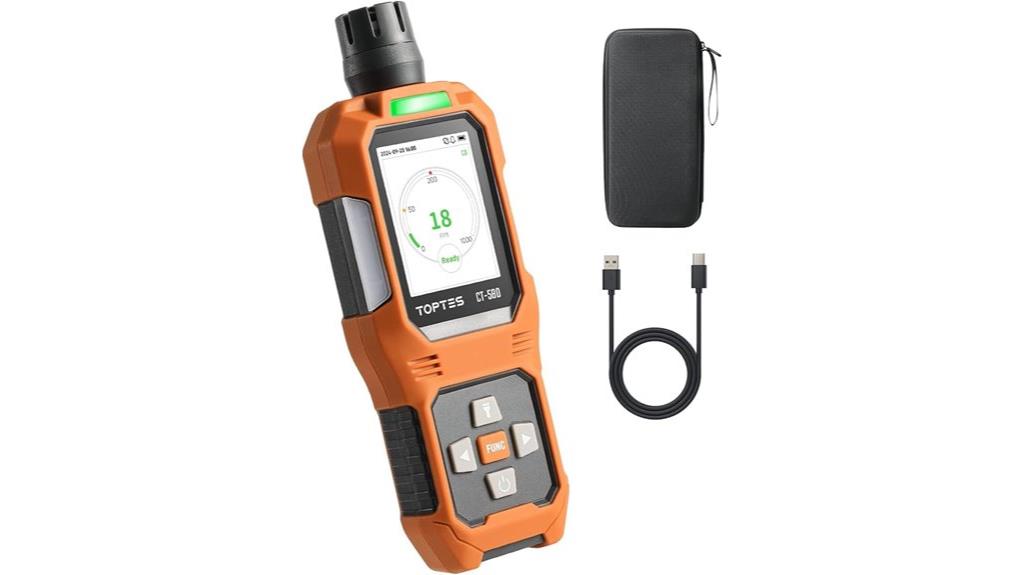
When safety and quick response matter most during winter heating, the TOPTES CT-580 Portable Carbon Monoxide Detector stands out as a top choice. It uses a high-sensitivity DDS sensor to detect CO levels within 0.3 seconds and provides clear alerts via visual, audible, and vibration alarms. Its TFT color display makes readings easy to interpret, while features like adjustable brightness, auto screen-off, and a built-in flashlight add convenience. Rechargeable via USB-C, it’s durable, portable, and suitable for home or travel. Certified for accuracy, the CT-580 offers reliable protection, ensuring you’re promptly warned of dangerous CO levels during cold months.
Best For: Homeowners, travelers, and professionals seeking quick, reliable CO detection during winter heating or outdoor activities.
Pros:
- Rapid response time of 0.3 seconds with high-sensitivity DDS sensor
- Multiple alarm alerts (visual, audible, vibration) for enhanced safety
- Portable and durable design with rechargeable USB-C power and added convenience features
Cons:
- Relatively larger size may reduce portability for some users
- Requires calibration and advanced settings for professional-grade accuracy
- Limited to CO detection; not suitable for multi-gas monitoring
Portable Carbon Monoxide Detector with Magnetic Mount and Rechargeable Battery
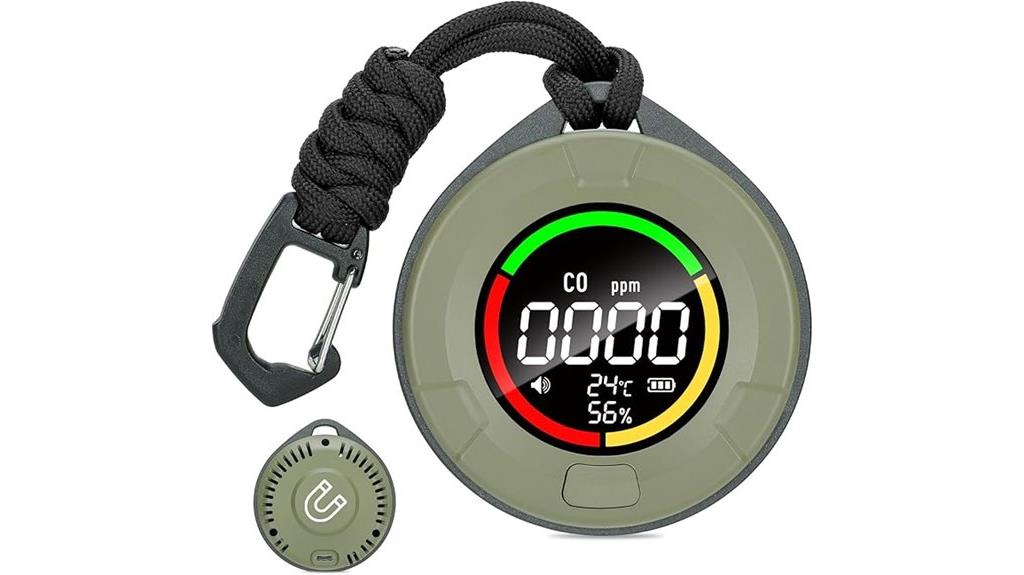
A portable carbon monoxide detector with a magnetic mount and rechargeable battery is an excellent choice for anyone who needs reliable, real-time air quality monitoring during outdoor activities or travel. It features a 3-in-1 design that tracks CO levels, temperature, and humidity with a high-precision sensor, providing instant updates. Its adjustable alarm thresholds and clear light indicators ensure safety in various environments. The rechargeable 1000mAh battery charges quickly via Type-C and offers up to 120 hours of standby time. Its magnetic back allows easy attachment to metal surfaces, while the compact size and outdoor lanyard make it perfect for camping, hiking, or home use.
Best For: outdoor enthusiasts, travelers, and homeowners seeking reliable, real-time CO, temperature, and humidity monitoring in a portable, easy-to-use device.
Pros:
- Portable and lightweight design with magnetic mount and outdoor lanyard for versatile placement
- Fast charging with up to 120 hours standby time for long-term use
- Customizable alarm thresholds and instant environmental updates enhance safety and convenience
Cons:
- Limited to a detectable CO range of 0-500PPM, which may not cover extremely high concentrations
- Requires regular charging and proper storage to maintain battery health over time
- May be less suitable for large-scale or industrial CO monitoring applications
Klein Tools CO Meter, Carbon Monoxide Tester and Detector

If you need a reliable CO detector that’s portable and easy to use during safety inspections, Klein Tools ET110 CO Meter stands out. It detects and measures carbon monoxide levels accurately, with a clear, backlit display showing CO concentrations and temperature. Its dual alarm system alerts you at low (35 ppm) and high (200 ppm) CO levels, with audible and visual warnings for safety. The device includes auto-power off to save batteries, along with four AAA batteries and a convenient carrying pouch. Built-in STEL alarms add extra protection, making this meter a dependable tool for monitoring CO levels in various environments.
Best For: DIY homeowners, safety inspectors, and professionals needing portable, reliable CO detection during safety inspections.
Pros:
- Accurate detection and measurement of carbon monoxide levels with clear display
- Dual alarm system with audible and visual alerts at both low and high CO levels
- Compact and portable design with auto-power off and included carrying pouch for convenience
Cons:
- Limited to 4 AAA batteries, which may need frequent replacement with heavy use
- Does not specify additional features like data logging or Bluetooth connectivity
- Requires manual calibration for long-term accuracy over time
Smoke and Carbon Monoxide and Heat Detector (3-in-1 CO/Smoke/Temp Alarm)
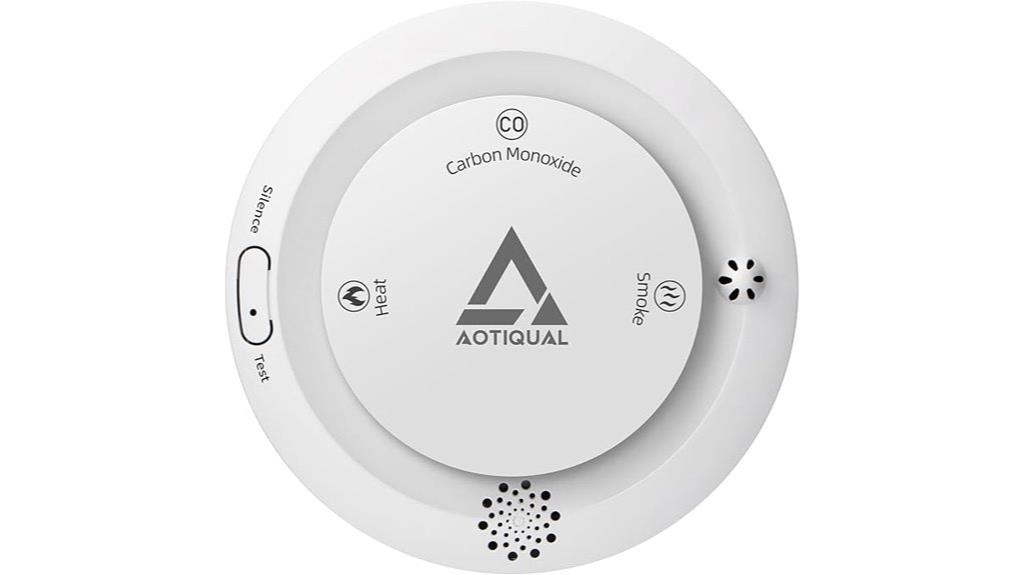
For those seeking thorough home safety during winter heater use, the Smoke, Carbon Monoxide, and Heat Detector (3-in-1 CO/Smoke/Temp Alarm) stands out with its all-in-one detection system. It combines sensors for CO, smoke, and heat, providing extensive protection. The long-lasting 10-year battery and loud 85dB voice alarm ensure quick alerts and minimal maintenance. Its explosion-proof ABS design offers durability in various environments. Easy to install with included batteries, screws, and manual, this device is highly rated and reliable. It’s a practical choice for safeguarding your home against multiple hazards during the cold months.
Best For: homeowners seeking comprehensive, maintenance-free safety detection during winter heating season with reliable alerts and easy installation.
Pros:
- Combines CO, smoke, and heat detection in one device for complete home safety.
- 10-year long-lasting battery reduces the need for frequent replacements.
- Loud 85dB voice alarm ensures quick and clear alerts for immediate response.
Cons:
- Requires initial installation with screws and setup, which may be challenging for some users.
- Limited to a 10-year lifespan, after which replacement is necessary.
- May not be suitable for outdoor use or extremely humid environments outside specified operating humidity.
Carbon Monoxide Detector Plug-in Wall, KH106
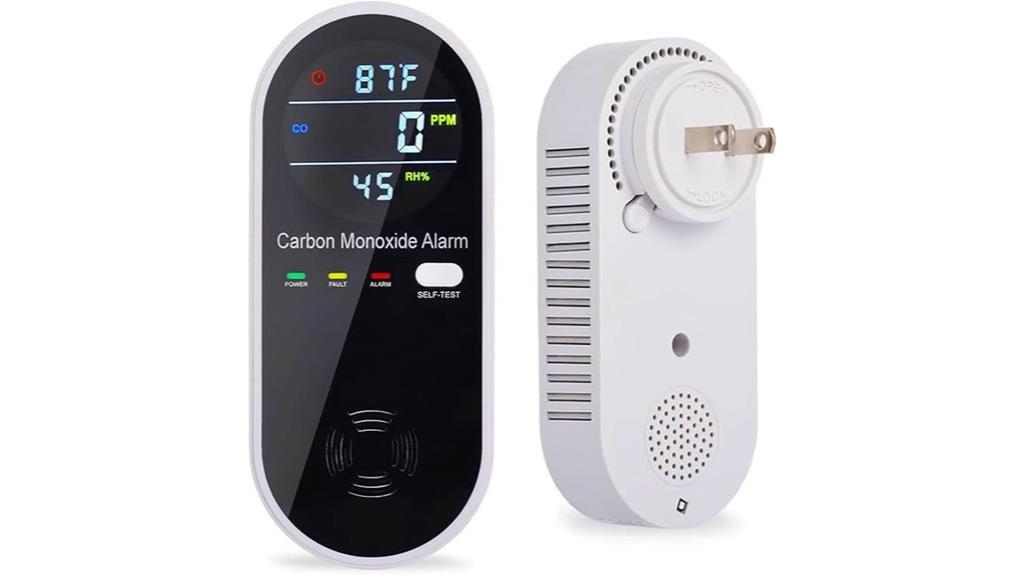
The Carbon Monoxide Detector Plug-in Wall, KH106 stands out as an ideal choice for those seeking a dependable, easy-to-use safety device that can monitor multiple environmental factors. Its plug-in design makes installation straightforward, and the big color LCD display ensures clear readings day or night. With 3-in-1 detection—CO levels, temperature, and humidity—it provides thorough environmental monitoring. Equipped with an imported electrochemical sensor, it offers high reliability and durability. The device’s voice and light alarms activate when CO exceeds 150 PPM, alerting you promptly. Compact and portable, it’s perfect for home, travel, or camping, giving peace of mind wherever you are.
Best For: individuals and families seeking a reliable, easy-to-use carbon monoxide, temperature, and humidity monitoring device suitable for home, travel, or camping environments.
Pros:
- Easy plug-and-play setup with a clear, big LCD display for easy reading day or night.
- 3-in-1 detection of CO, temperature, and humidity for comprehensive environmental monitoring.
- Compact, lightweight, and portable design ideal for various locations including travel and outdoor activities.
Cons:
- No batteries included; relies solely on AC power, which may limit placement options during power outages.
- Limited to a maximum of 1000 PPM CO detection, which may not cover extremely high-risk environments.
- May require regular calibration over time to ensure continued accuracy of sensors.
First Alert CO710 Carbon Monoxide Detector with 10-Year Battery

When choosing a CO detector for winter heater use, the First Alert CO710 stands out thanks to its 10-year battery life, ensuring continuous protection without the hassle of frequent replacements. It features a sleek design suitable for tabletop or dresser placement and includes a backlit digital display showing ambient temperature, current, and peak CO levels. The electrochemical sensor provides precise detection of the invisible, odorless CO gas. An 85-decibel alarm alerts me to dangerous levels, and the test/silence button makes checks easy. With a built-in end-of-life signal and UL certification, I trust this detector for reliable, maintenance-free safety during the cold months.
Best For: homeowners seeking a maintenance-free, reliable carbon monoxide detector with a long-lasting battery and easy placement during winter months.
Pros:
- 10-year built-in lithium battery eliminates the need for replacements and ensures continuous protection
- Digital backlit display shows temperature and CO levels for quick monitoring
- Certified to UL standards, providing trusted safety assurance
Cons:
- Limited to a fixed 10-year lifespan, requiring replacement after end-of-life signal
- May be less suitable for those preferring plug-in models with external power options
- Compact size may be less noticeable in larger or more decorative home settings
Kidde Battery-Powered Carbon Monoxide Detector
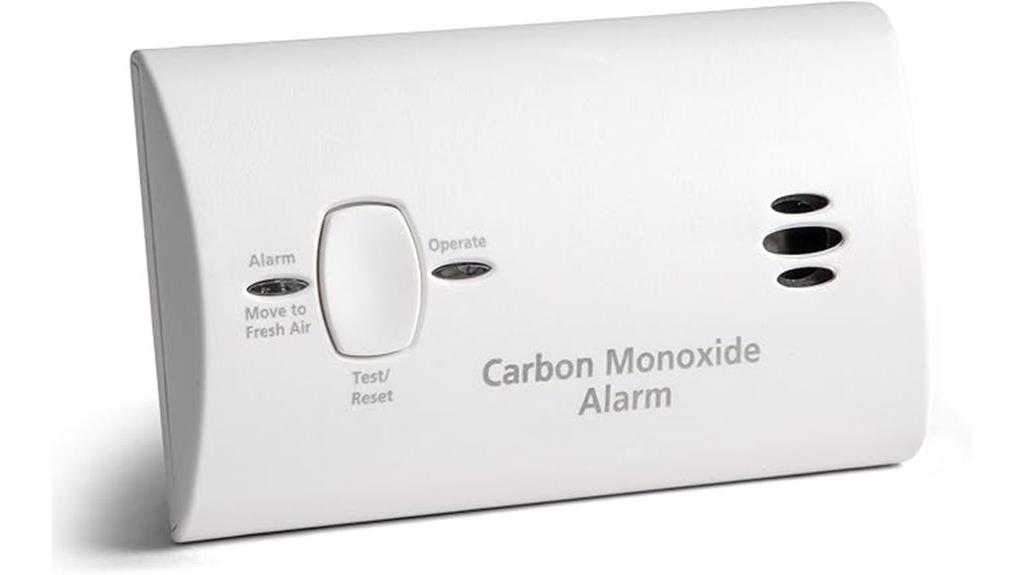
If you’re looking for a reliable CO detector that works even during power outages, the Kidde Battery-Powered Carbon Monoxide Detector is an excellent choice. It uses electrochemical sensors for accurate detection and is powered by two AA batteries, ensuring protection when the power goes out. You can wall-mount or place it on a tabletop, making it versatile for any room. The alarm sounds at 85 decibels, with red LEDs pulsing during detection and green LEDs indicating proper operation. Features like a test-reset button, low battery indicator, and event memory make maintenance easy. Certified by UL, it offers a 7-year lifespan and a 10-year warranty, providing peace of mind.
Best For: homeowners seeking a reliable, portable carbon monoxide detector that functions during power outages and is easy to install and maintain.
Pros:
- Battery-powered with a 7-year lifespan, ensuring continuous protection without wiring.
- Easy to install on walls or tabletop, suitable for all living areas.
- Features a test-reset button, low battery indicator, and safety lockout for user convenience.
Cons:
- Requires battery replacement after several years, which adds ongoing maintenance.
- May produce false alarms if not properly maintained or installed.
- Limited to residential use; not suitable for industrial or commercial environments.
Kidde Carbon Monoxide Detector with Digital LED Display

For homeowners seeking reliable safety during winter heating, the Kidde Carbon Monoxide Detector with Digital LED Display stands out thanks to its clear, real-time gas level readings. Its plug-in design with a 9-volt backup ensures continuous protection even during power outages. The digital display updates every 15 seconds, showing precise levels from 30 to 999 ppm, while the LED indicators and peak level memory help track gas trends. Equipped with smart hush buttons and audible alerts, it effectively signals elevated CO or explosive gases, like methane and propane. Certified to UL standards and built to last around seven years, this detector offers peace of mind for every home.
Best For: homeowners seeking reliable, real-time detection of carbon monoxide and explosive gases to ensure safety during winter heating and everyday activities.
Pros:
- Digital LED display provides clear, real-time gas level readings from 30 to 999 ppm.
- Plug-in design with 9-volt battery backup ensures continuous protection during power outages.
- Certified to UL standards with a lifespan of around seven years, offering long-term safety and peace of mind.
Cons:
- Requires regular replacement every 5-7 years for optimal performance.
- Installation must be at least 15 feet from appliances to ensure accurate readings.
- Limited to indoor use; not suitable for outdoor environments or areas exposed to moisture.
4-in-1 Natural Gas and Carbon Monoxide Leak Detector

Looking for a reliable detector that safeguards your home from both natural gas and carbon monoxide leaks? The 4-in-1 Natural Gas and Carbon Monoxide Leak Detector is an excellent choice. It combines sensors for natural gas, CO, temperature, and humidity into a compact device. With dual alarms and loud alerts (≥85 dB), it quickly notifies you of dangerous gas levels. The full-color LCD displays real-time readings, and its plug-in design supports 110V–220V power, ensuring energy efficiency and long-term use. Easy to set up and calibrate, this device offers all-encompassing safety for your home, RV, or hotel room, making it a versatile and essential safety tool.
Best For: homeowners, RV owners, and hotel managers seeking a reliable, all-in-one gas and environmental monitoring device for enhanced safety.
Pros:
- Combines multiple sensors for natural gas, CO, temperature, and humidity in a compact design
- Equipped with dual alarms and loud alerts (≥85 dB) for rapid danger notification
- Supports energy-efficient plug-in operation with real-time LCD display for easy monitoring
Cons:
- Requires initial calibration and setup time before use
- Limited to 110V–220V power supply, not compatible with 110V or 220V alone without adapters
- May need periodic sensor calibration or replacement for long-term accuracy
Kidde Hardwired Heat Detector with Battery Backup
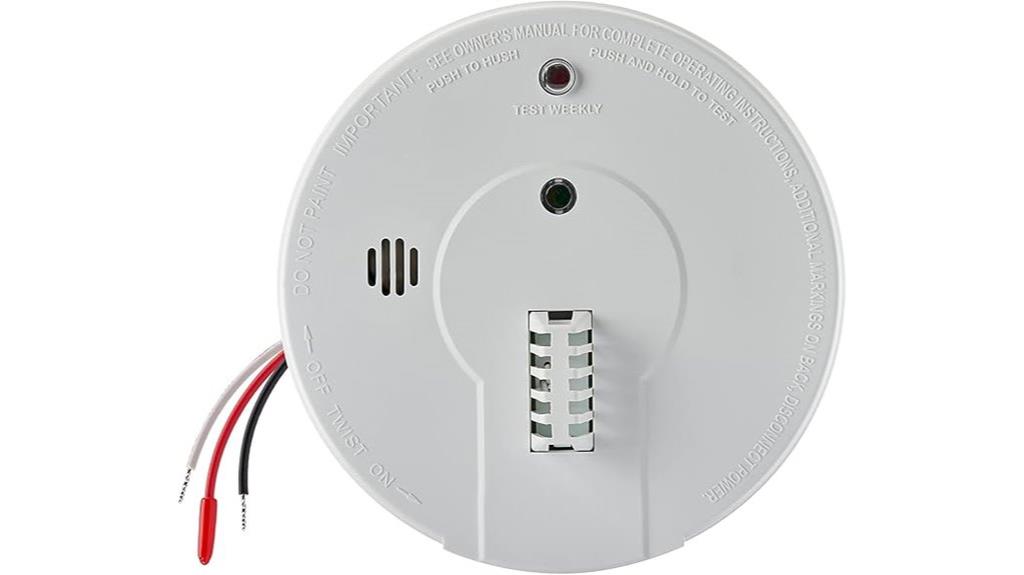
The Kidde Hardwired Heat Detector with Battery Backup stands out for homeowners who want reliable heat detection combined with easy installation and continuous protection. It’s designed for garages and other areas prone to temperature fluctuations, alerting you when temperatures rise above 135°F with an 85-decibel alarm. The unit features two LEDs—one for visual alerts—and supports interconnection with up to 18 alarms, ensuring thorough coverage. Powered by a 120V wired source with a backup 9-volt battery, it provides uninterrupted safety. The quick-connect harness makes installation simple, and the Test-Hush button helps manage false alarms efficiently.
Best For: homeowners seeking a reliable, easy-to-install heat detector for garages or areas prone to temperature fluctuations.
Pros:
- Easy quick-connect harness simplifies installation.
- Supports interconnection with up to 18 alarms for comprehensive coverage.
- Battery backup ensures continuous protection even during power outages.
Cons:
- Detects only temperatures rising above 135°F, not smoke or other hazards.
- May require professional wiring for hardwired setup.
- Limited to 5-year manufacturer warranty, which may necessitate replacement past that period.
First Alert Hardwired Heat Alarm with Battery Backup, BRK Brands HD6135FB

If you need a heat detector that provides reliable protection even during power outages, the First Alert Hardwired Heat Alarm with Battery Backup (BRK Brands HD6135FB) is an excellent choice. It’s designed for areas where smoke alarms aren’t suitable, using advanced rate-of-rise sensing technology to detect high or rapidly increasing temperatures. The microprocessor-controlled system helps minimize false alarms, while the loud 85-decibel alarm ensures you’ll hear it in an emergency. Plus, it can be remotely tested and muted with most household remote controls, adding convenience. Its hardwired setup with battery backup guarantees continuous operation, giving you peace of mind during power failures.
Best For: homeowners and property managers seeking a reliable heat detection system that functions during power outages and is suitable for areas where smoke alarms are not appropriate.
Pros:
- Hardwired installation with battery backup ensures continuous operation during power outages
- Advanced rate-of-rise sensing technology effectively detects high and rapidly increasing temperatures
- Microprocessor-controlled system reduces false alarms for more reliable performance
Cons:
- Can only be tested and muted remotely using compatible household remote controls (sold separately)
- Not suitable for detecting smoke or slow temperature changes, limiting its scope of fire detection
- Installation may require professional assistance for hardwired setup in some homes
Kidde Carbon Monoxide Detector with Battery Backup

For those seeking a reliable CO detector that works seamlessly during winter outages, the Kidde Carbon Monoxide Detector with Battery Backup is an excellent choice. It’s easy to install—simply plug it into a standard 120V outlet—and it features a backup battery that keeps it running during power failures. The 85-decibel alarm promptly alerts me if CO is detected, while the Peak Level Memory records the last detection or test. The Test-Hush Button makes testing the device or silencing false alarms straightforward. Overall, it offers dependable protection with user-friendly features, ensuring my home stays safe even during winter outages.
Best For: those seeking a reliable, easy-to-install carbon monoxide detector with backup power for peace of mind during power outages.
Pros:
- Easy to install by simply plugging into a standard 120V outlet
- Battery backup ensures continuous protection during power outages
- Loud 85-decibel alarm effectively alerts to CO presence and the Peak Level Memory records last detection
Cons:
- Limited to plug-in installation; not suitable for hardwired setups
- Uses 2-AA batteries, which require periodic replacement
- May not have advanced smart features or connectivity options
Kidde Carbon Monoxide Detector with Battery Power
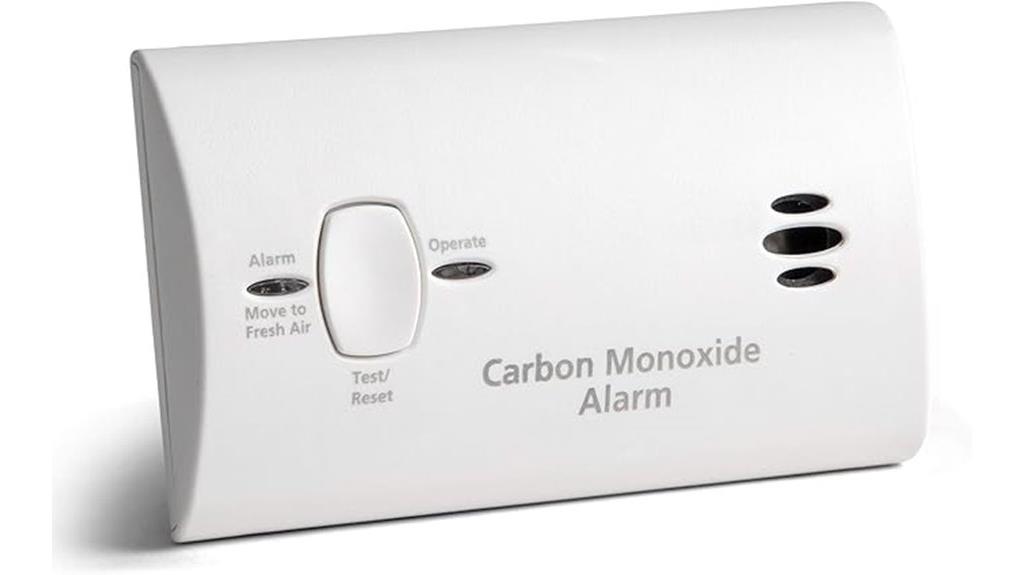
A battery-powered CO detector like the Kidde model is an ideal choice for households seeking reliable safety without the hassle of wiring or constant power dependence. It runs on 2-AA batteries, which are included, ensuring it works even during power outages. The device features easy installation options—wall mounting or tabletop placement—making setup simple. Its LED indicators show power and CO detection status, while the 85-decibel alarm alerts you immediately to danger. The low battery indicator prompts timely replacements, and the electrochemical sensor provides accurate detection. Plus, its portable design allows flexible placement, giving you peace of mind wherever you need it most.
Best For: households seeking a reliable, portable, and easy-to-install carbon monoxide detector that functions during power outages without the need for wiring.
Pros:
- Battery-powered with included 2-AA batteries ensures continuous operation during outages
- Easy to install and reposition with wall-mount or tabletop options
- Clear visual and audible alerts with LEDs and an loud 85-decibel alarm for quick detection
Cons:
- Limited to local alerts; does not connect to smart home systems or provide remote notifications
- Battery life may require regular replacement to maintain optimal performance
- Electrochemical sensors, while accurate, may need periodic calibration or replacement over long-term use
Factors to Consider When Choosing a CO Detector for Winter Heater Use

When choosing a CO detector for winter heaters, I consider several key factors to guarantee safety and reliability. Things like detection sensitivity, backup power options, and alarm loudness matter because they directly impact how well the detector performs during cold months. Additionally, proper placement and maintenance help ensure continuous protection when it’s needed most.
Detection Sensitivity Levels
Choosing the right CO detector for winter heater use hinges on understanding its detection sensitivity levels, which directly impact how quickly it alerts you to rising carbon monoxide. Sensors with higher sensitivity detect lower CO concentrations, providing earlier warnings during potential leaks. Regulatory standards often set minimum thresholds, like 70 ppm for 60 minutes or 150 ppm for immediate alarms, guaranteeing reliable protection. However, overly sensitive detectors may trigger false alarms from minor fluctuations, while less sensitive ones could delay alerts during dangerous leaks. Finding a detector with balanced sensitivity allows for accurate detection without nuisance alarms. This guarantees you’re protected during winter heating, when CO risks increase, without unnecessary interruptions. Proper sensitivity selection is vital for maintaining a safe home environment.
Power Backup Options
During winter heater use, guaranteeing your CO detector has a dependable power backup is essential because power outages are common during storms. A reliable backup, like long-lasting sealed batteries such as 10-year lithium ones, keeps your detector operational without frequent maintenance. Some models use plug-in power with battery backup, offering flexibility if the main power fails. It’s important to choose a backup source that is easily replaceable or maintenance-free to ensure continuous safety. Verify that the battery backup provides sufficient runtime, especially during extended outages, so you’re alerted in time. Safety standards should be met, and the backup system should be designed to keep the detector working reliably until power is restored. This ensures your home stays protected during winter storms.
Alarm Loudness & Alerts
Ensuring your CO detector has a loud enough alarm is crucial, especially during winter when you might be asleep or in a different room. A minimum of 85 decibels is necessary to guarantee you hear the warning from a distance or when you’re sleeping. Some detectors include visual flashing lights or vibration alerts to complement the sound, providing multiple notification methods. The alarm should trigger promptly at low CO levels, giving you early warning before dangerous concentrations develop. Using alarms with different tones or patterns helps distinguish a CO alert from other household sounds. Additionally, a test or silence button allows you to verify the alarm’s functionality and silence false alarms temporarily without compromising safety. These features ensure reliable and effective alerts in case of CO danger.
Sensor Longevity & Maintenance
A reliable CO detector must stay accurate over time, especially when using it with winter heaters that can produce fluctuating indoor conditions. Regular testing and calibration are vital to guarantee the sensor remains precise. Follow the manufacturer’s schedule to replace the sensor or the entire unit, usually every 5 to 7 years, to prevent false readings or sensor failure. Keeping the detector clean from dust, debris, or insects helps maintain sensor function and reduces false alarms. Also, verify your detector operates within its specified temperature and humidity ranges, which supports sensor longevity. Don’t ignore the end-of-life indicator—replacing the detector promptly before sensor degradation occurs is essential for ongoing safety. Proper maintenance guarantees reliable, accurate detection when you need it most.
Placement & Installation Tips
Choosing the right spot for your CO detector is essential for accurate safety monitoring, especially when winter heaters are in use. I recommend installing detectors at least 15 feet away from fuel-burning appliances to prevent false alarms. Place them in sleeping areas to ensure alertness during the night. Mount the detectors on the wall or ceiling, following the manufacturer’s height guidelines—usually 1.5 to 2 feet above the floor. Avoid locations near windows, vents, or high airflow areas, as these can dilute CO levels or cause false alarms. Make sure the detector is accessible for regular testing and battery replacement, especially if it’s battery-powered. Finally, verify it’s installed within the recommended humidity and temperature range to keep sensors accurate.
Compatibility With Heaters
When selecting a CO detector for winter heater use, it’s important to match the device with your heater’s power source and emission profile. Make sure the detector is compatible with your heater’s power setup—whether it’s plug-in, hardwired, or battery-operated. Check that its sensor type and detection range suit the emissions your heater produces, especially for combustion-based units. Additionally, review the placement instructions to ensure the detector can be installed near vents or combustion areas if needed. Consider environmental factors like temperature and humidity; your detector should operate reliably within those conditions. If you have a smart or interconnected safety system, verify that the CO detector can integrate seamlessly. Compatibility ensures accurate detection and reliable safety during winter heating.
Certification & Safety Standards
Ensuring your CO detector meets recognized safety standards is essential for reliable protection during winter heating. I always look for certifications from trusted organizations like UL, ETL, or CSA, which guarantee the device has passed rigorous testing. Specifically, I check that the detector complies with UL 2034, a standard that covers performance and safety requirements for carbon monoxide alarms. A clear safety certification label on the device or packaging gives me confidence it’s been verified. I also verify that the model is approved for use in my region, whether it’s CE marking for Europe or CSA approval for Canada. Regularly checking these certifications and expiration dates helps ensure my detector remains compliant and effective, providing peace of mind throughout the winter months.
Frequently Asked Questions
How Often Should CO Detectors Be Tested During Winter?
You should test your CO detectors once a month during winter to guarantee they’re working properly. I make it a habit to press the test button regularly and replace the batteries at least twice a year, especially when the seasons change. It’s a quick check that can save lives, so don’t skip it. Staying vigilant helps keep your home safe from carbon monoxide buildup when heaters are running full blast.
Can Multiple CO Detectors Be Interconnected for Better Safety?
Yes, multiple CO detectors can be interconnected for better safety. I recommend installing interconnected detectors throughout your home, especially near bedrooms and heating sources. When one detects carbon monoxide, all alarms sound simultaneously, alerting everyone promptly. This setup provides added safety and peace of mind during winter heater use. Just make sure all detectors are compatible with each other and properly installed according to the manufacturer’s instructions for maximum effectiveness.
Are CO Detectors Safe to Use Near Heating Vents?
Yes, CO detectors are safe to use near heating vents. I always make sure they’re installed at the right height and away from direct airflow to avoid false alarms. Placing them near vents helps detect any leaks early, especially during winter when heaters run more often. Just make sure they’re installed according to the manufacturer’s instructions, and you’ll have reliable protection without worries about safety.
What Are the Signs of CO Poisoning to Watch For?
If you start feeling dizzy, nauseous, or breathless, it’s time to panic—your body’s telling you CO poisoning might be sneaking in. Headaches, confusion, or fatigue are sneaky signs too. I always say, if you notice these symptoms, open windows fast and get fresh air. Don’t wait for a dramatic fainting scene—trust me, your body’s warning signals are your best alarm. Stay alert!
How Do I Replace Batteries in a Hardwired CO Detector?
To replace the batteries in a hardwired CO detector, I first turn off the power at the circuit breaker for safety. Then, I remove the detector from its mounting bracket, usually by twisting or sliding it off. I take out the old batteries, insert new ones, ensuring correct polarity, and reattach the detector. Finally, I turn the power back on and test the unit to make sure it works properly.
Conclusion
Stay safe this winter by selecting a dependable CO detector that delivers peace of mind and prevents peril. Prioritize proper placement, battery backup, and smart features to guarantee continuous protection. Remember, prevention is power—don’t delay in deploying a device that detects danger before it’s too late. With the right detector, you can confidently cozy up, knowing your home is protected from harmful hazards. Stay savvy, safe, and secure all season long!








